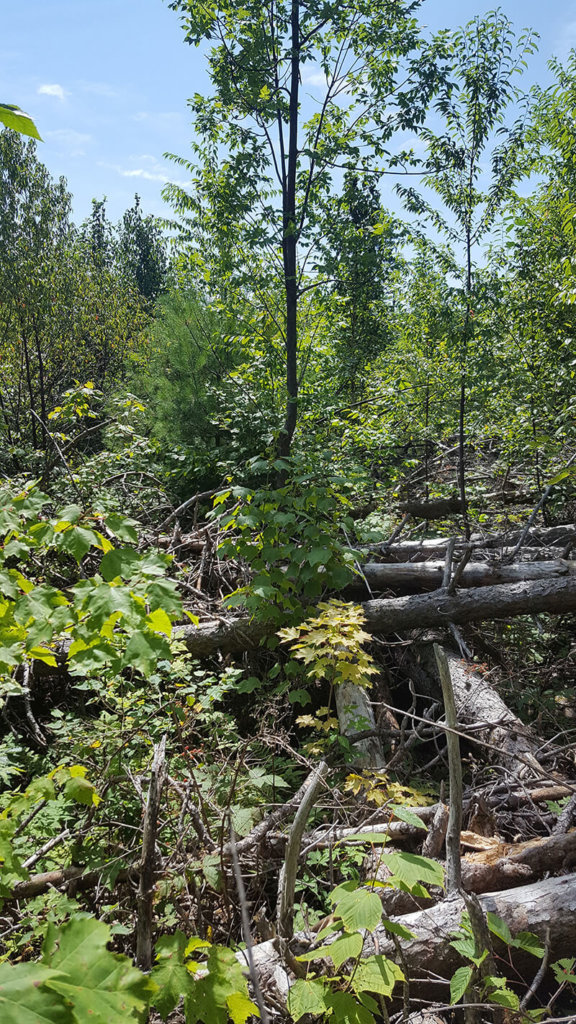A regeneration story
 Believe it or not, every big tree was once a little tree and, before that, a seed. Yes, those massive trunks and branches that took decades or centuries to grow were once acorns lying on the ground or aspen seeds blowing in the wind. While we value our big trees, we often forget the small trees and seeds we see today are what will become the massive maples and oaks that our great-grandchildren will admire.
Believe it or not, every big tree was once a little tree and, before that, a seed. Yes, those massive trunks and branches that took decades or centuries to grow were once acorns lying on the ground or aspen seeds blowing in the wind. While we value our big trees, we often forget the small trees and seeds we see today are what will become the massive maples and oaks that our great-grandchildren will admire.
When foresters or loggers make the sometimes unpopular decision to harvest large trees in order to release existing small trees or to create space for new trees to grow, it is important to remember this. Encouraging the growth of new trees is usually the most difficult and finicky part of growing healthy forests and one that requires a robust understanding of how our native tree species reproduce, establish and grow.
How trees of different species reproduce, and how the resulting seeds and young trees (“seedlings”) capitalize on disturbances (the death of trees) to establish and compete for growing space, is the process of “regeneration.” Vermont’s tree species have several prominent strategies for regenerating, which I will divide into several categories here. And within these categories are many nuances based on species, site and situation.
The easiest way for trees to reproduce is to use an existing root system. Once a tree dies or is cut, several tree species are skilled at sprouting aggressively from their roots or stem, reproducing “asexually” by producing clones of the parent tree. Prominent root-sprouters include aspens (poplars, cottonwood) and beech; stump-sprouters include red maple and red oak. In both cases, this means that small trees of these species may be much older than they appear. Utilizing an established root system allows these young trees to grow quickly and outcompete other young trees who have to start from scratch—growing from seed.
Several of our tree species take the tactic of producing an abundance of small, “cheap,” very mobile seeds. While these seeds are not very rugged, they blanket the landscape, some of them invariably finding somewhere suitable to grow. Species that employ this strategy include birches and aspens, which are often the first trees to regenerate in highly disturbed environments. In winter yellow and black birch produce seeds like this, which are blown across the surface of snow.
Another strategy is to lie in wait. Anyone who has tried to walk through a forest three to five years after a natural or human-caused disturbance has probably noticed an abundance of blackberries and raspberries. The seeds of these species are not introduced to the site after the disturbance; rather they had been collecting in the soil for years, courtesy of the birds and bears that eat and pass their fruits. These seeds are resistant to germination—sometimes remaining viable in the soil for 60 to 100 years before germinating—but when they sense a disturbance they grow aggressively. Once thought to interfere with our native plants, it is now understood that blackberries and raspberries enrich disturbed environments through nutrient-cycling and shelter young seedlings.
A fourth strategy is to produce large, “expensive” seeds, which sprout and persist in the understory of the forest, waiting for a disturbance. Red oak, red spruce and sugar maple are among the species that invest a lot of energy in their seeds, producing a glut of them at irregular intervals (called “mast years”). The resulting seedlings spend years establishing a deep root system, feeding off the energy in their seeds. These seedlings are very shade tolerant and are sometimes able to remain in this condition, as advance regeneration (regeneration that exists in advance of a disturbance) for decades, waiting for the trees above them to fall. Once they do, these seedlings quickly shoot skyward with the benefit of an established root system. Unfortunately, when these seedlings are waiting around in the understory they are extremely vulnerable to browsing and competition from invasive plants. Their energy-packed seeds are also often preferred wildlife food, and so just being able to sprout can be challenging.
While we all admire the large trees that punctuate our forest, take a moment to appreciate the regeneration down at our feet. The towering trees that will shade our grandchildren’s grandchildren are down there, just trying to catch a break.
Ethan Tapper is the Chittenden County forester. He can be reached via email, by phone at (802) 585-9099, or at his office at 111 West Street, Essex Junction.

